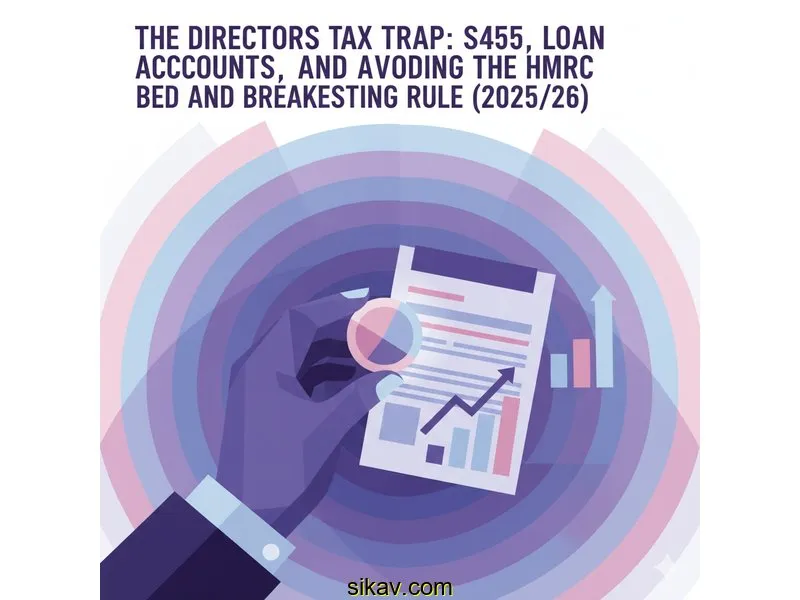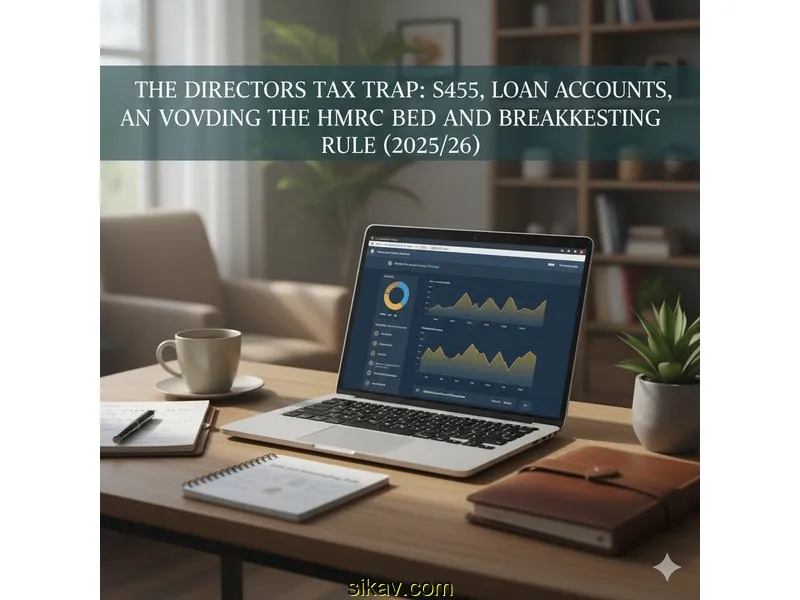
Picture this: You’re the sole director of a successful UK limited company. Revenue is coming in, and to cover a personal expense—maybe a new kitchen or a large investment—you take £25,000 out of the business bank account before formally declaring it as salary or dividends. This is known as a **Director’s Loan Account (DLA) that is overdrawn**. It’s a common occurrence, often done innocently to manage cash flow. However, if you've felt that momentary panic wondering: **“What is the deadline for repaying this to avoid a massive tax bill?”**—you’re certainly not alone.
Managing an overdrawn Director’s Loan Account correctly isn’t just about bookkeeping; it’s a critical **tax planning exercise** that directly impacts your company’s Corporation Tax bill and your personal liability. Getting the DLA rules wrong is a trip hazard for even experienced directors. The core issue revolves around **Section 455 (S455) Corporation Tax** and a specific anti-avoidance rule HMRC calls **"Bed and Breakfasting,"** which can effectively double your tax pain. Let's explore how to navigate this high-stakes scenario and keep your personal and company finances compliant.
Key Takeaways
- S455 Tax Rate: If your overdrawn DLA is not repaid within **nine months and one day** of your company's year-end, the company must pay S455 Corporation Tax at a rate of **33.75%** on the outstanding balance (HMRC, 2024/25).
- The Deadline is Fixed: For a company with a 31 March year-end, the repayment deadline is **1 January** of the following year. Miss this by a day, and the tax is triggered.
- Bed and Breakfasting Trap: Repaying a large DLA just before the deadline and taking it out again soon after can be challenged by HMRC, who may still apply the S455 charge. This is the "Bed and Breakfasting" anti-avoidance rule.
- Interest-Free Loans: An interest-free DLA exceeding **£10,000** triggers a separate **Benefit in Kind (BIK)** tax charge for the director, reported on a P11D form.
- Disclaimer: This article provides informational guidance based on HMRC rules as of November 2025. It is not financial or legal advice. DLA rules are complex and penalties for errors are significant—always consult a qualified accountant for your specific situation.
Understanding the Director's Loan Account and S455 Tax
A Director's Loan Account is simply a record of transactions between a limited company and its director that are not salary, dividends, or reimbursed expenses. When the company owes the director money, the DLA is 'in credit' (the company has a liability). When the director owes the company money—meaning they have taken more out than they’ve put in—the DLA is **'overdrawn'** (the director has a liability).
The fundamental tax issue arises when the DLA is overdrawn at the company's year-end. HMRC views this as the company making a loan to a 'participator' (the director). This action attracts a special type of Corporation Tax, known as **S455 tax** (named after the relevant section of the Corporation Tax Act 2010).
Think of S455 tax as a **temporary, punitive tax deposit** that the company must pay to HMRC. In the 2025/26 tax year, this rate is **33.75%** of the outstanding loan balance. Why so high? Because it's designed to disincentivise directors from using their company as a personal tax-free bank. If the loan is fully repaid, the S455 tax is eventually refunded to the company, but not until nine months and one day after the end of the accounting period in which the repayment occurred—meaning the company loses the use of that cash for at least a year.
For context, official HMRC data shows that the number of investigations into Director’s Loan Account abuses has significantly increased over the past three years as HMRC focuses on compliance among small to medium-sized enterprises (HMRC Compliance Review, 2024).
The Critical Repayment Deadline and Repayment Options

The single most important deadline for an overdrawn DLA is the date falling **nine months and one day** after the company's year-end. Repay the loan *before* this date, and the S455 tax charge is completely avoided. Miss it, and the company must pay the 33.75% tax. Here's a look at the most common scenarios and the consequences.
| Scenario (All for a £25,000 Loan) | Year-End (Example) | S455 Repayment Deadline | S455 Tax Payable (33.75%) | Consequence |
|---|---|---|---|---|
| **Repayment Before Deadline** | 31 March 2025 | 1 January 2026 | £0 | No S455 tax is charged. Director is compliant. |
| **Repayment After Deadline (e.g., Feb 2026)** | 31 March 2025 | 1 January 2026 | £8,437.50 | S455 tax is paid to HMRC. Company claims a refund nine months and one day after the date of repayment (e.g., Nov 2026). Cash flow is impacted. |
| **DLA Written Off as Dividend** | 31 March 2025 | 1 January 2026 | £0 | No S455 tax. The director receives a 'net' dividend equivalent to the loan, but must account for personal Dividend Tax via Self-Assessment. The director's tax bill may be higher than S455 tax. |
| **DLA Written Off as Salary/Bonus** | 31 March 2025 | 1 January 2026 | £0 | No S455 tax. The director pays Income Tax and National Insurance (NI) on the loan amount via PAYE. Often the least tax-efficient option. |
As you can see, the outcome is highly dependent on timing. While writing off the loan as a dividend or salary avoids S455 tax for the company, it simply shifts the tax burden (and potentially increases it) to the director's personal tax return via Income Tax and/or Dividend Tax. A qualified accountant can model these scenarios to find the most efficient path.
The 'Bed and Breakfasting' Anti-Avoidance Rule
The most dangerous trap for the unwary director is the HMRC anti-avoidance rule targeting what’s commonly called **"Bed and Breakfasting"** the loan. Picture this: A director repays the loan on 30 December (just before the 1 January deadline for a March year-end) using a personal bank transfer, but then, a few weeks later, takes out an identical loan on 1 February.
HMRC is wise to this tactic. The rule, contained in Section 464C, prevents directors from getting a tax advantage by:
- Repaying an overdrawn DLA of more than **£5,000** just before the nine-month deadline; AND
- Taking out a **new loan** of more than £5,000 within **30 days** of the repayment.
This challenge is particularly relevant as HMRC data indicates that around **45% of S455 inquiries** involve a suspected 'bed and breakfasting' scenario or a similar tax avoidance structure (HMRC Tax and Duty Policy, 2024). This shows HMRC is actively policing this behaviour.
Other DLA Consequences: Benefit in Kind (BIK)
Beyond S455 tax, there is a separate tax implication for the director personally, even if the S455 charge is avoided. This relates to **Benefit in Kind (BIK) tax** on cheap or interest-free loans.
The BIK rule is simple: if the overdrawn DLA exceeds **£10,000** at any point during the tax year and the company charges **zero or low interest** on the loan (i.e., less than HMRC’s official rate, currently 2.25% in the 2024/25 tax year), the director is deemed to have received a taxable benefit.
Think of the BIK charge as being taxed on the money you **saved** by not having to pay commercial interest on the loan. The director is taxed personally on the difference between the interest actually paid and the interest that would have been paid at HMRC’s official rate. This amount must be reported on the director’s **P11D** form, and the company has to pay Class 1A National Insurance on the benefit.
Step-by-Step: Managing an Overdrawn Director's Loan Account
1. Track Daily Balances: Ensure your bookkeeping software or accountant tracks the DLA balance daily. This is critical for monitoring the £10,000 BIK threshold and the year-end S455 status.
2. Identify the S455 Deadline: Note the **nine months and one day** deadline following your company's year-end in your calendar (e.g., 31 March year-end means 1 January deadline).
3. Plan Your Repayment Strategy: Decide whether you will repay the loan with personal funds, offset it with a formal dividend (requires sufficient distributable reserves), or write it off as salary/bonus. The dividend route is often the most tax-efficient, but requires careful timing.
4. Repay and Document: If you choose to repay, make the transfer well before the deadline and keep detailed records. If you repay and need to take money out again, ensure the 30-day anti-avoidance window is respected and that the new loan is legitimate and not part of a planned cycle.
Common Questions About Director's Loan Accounts
Based on questions I've seen across UK freelancer forums and Reddit's r/UKPersonalFinance, here are the three most common points of confusion directors face when dealing with their DLA.
If my company pays the S455 tax, is that the end of the matter?
No, paying the S455 tax is just the company covering its immediate tax liability. The loan itself remains on the company's balance sheet, and you, the director, still owe the company the money. The S455 tax is only repaid to the company once the loan is finally settled—meaning the company loses the use of that 33.75% for at least a year. Furthermore, the BIK charge on interest-free loans over £10,000 is still due personally, regardless of whether the S455 tax was paid or avoided.
Can I avoid the S455 tax by declaring a dividend to clear the loan just before the deadline?
Yes, this is a common, compliant way to clear an overdrawn DLA and avoid the S455 charge. However, the dividend must be **formally declared** (with proper board minutes) and the company must have sufficient **distributable reserves** to cover the dividend. Crucially, that dividend then becomes part of your personal income for that tax year, and you will pay Dividend Tax on it via your Self-Assessment. If you are a higher-rate taxpayer, this personal tax can be a significant cost. Always ensure the declared dividend is *not* part of a 'bed and breakfasting' scheme if you plan to immediately draw the money out again.
What happens if my loan is less than the £10,000 threshold?
If your overdrawn DLA is always **£10,000 or less** throughout the entire tax year, you successfully navigate two separate issues: you avoid the S455 tax (assuming it is repaid by the nine-month deadline), AND you avoid the personal **Benefit in Kind (BIK)** tax charge related to interest-free loans. This is often the safest threshold for directors to operate within, as it prevents multiple complex tax issues from being triggered. Nonetheless, the loan still requires careful tracking.
Conclusion: Your Next Steps
Understanding an overdrawn Director’s Loan Account is one of the most vital—and complex—areas of tax compliance for a UK limited company director. The rules are designed to prevent the company vehicle from being used for personal gain without paying the appropriate personal tax.
If you're a director with an overdrawn DLA, start by immediately confirming your **nine-month-and-one-day deadline**. Your primary goal is to ensure the account is in credit (or fully repaid) by that date to side-step the punitive 33.75% S455 tax. However, the most nuanced challenge is avoiding the **Bed and Breakfasting rule**; if you repay the loan, keep the funds in your personal account for longer than 30 days before drawing a new loan, or, ideally, offset the loan with a formal dividend (ensuring you have distributable profits). This guide provides a framework, but DLA rules are intricate, and penalties for errors are severe—for your specific business setup and tax strategy, always consult a qualified accountant who understands the nuances of cross-border digital sales.

